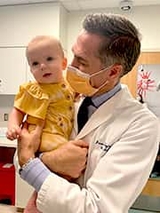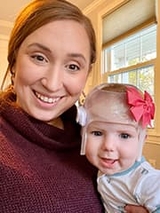Lambdoid Craniosynostosis: Nora’s Story
Lambdoid Craniosynostosis: Nora’s Story
“We learned more about skulls than we ever thought we would, in a very short amount of time.” That’s what Hannah and Jon say about finding out that their firstborn, Nora, had a condition called craniosynostosis, in which the growth seams in an infant’s skull close prematurely, causing problems with normal brain and skull growth. The Pittsburgh family sought care at Children's Hospital of Philadelphia (CHOP), where Jon says, “The teams went above and beyond.”

After what Hannah calls an “easy pregnancy,” Nora was born on her due date, and everything seemed normal. But after a few weeks, the parents noticed a ridge on the back of Nora’s head. “At her 2-month-old well visit, I said, ‘Something just doesn’t feel right,’” says Hannah. The pediatrician suggested seeing a specialist, and Hannah and Jon readily agreed. The thought was that Nora had developed a flat spot, called plagiocephaly, caused by too much time lying in the same position.
At that appointment, the specialist felt Nora’s head and then immediately called in a colleague. “That day we got a verbal diagnosis of lambdoid craniosynostosis,” says Hannah, which was soon verified through testing.
The least common form
Craniosynostosis, or premature closure, can involve any seam of the cranial vault or cranial base. There are seams, for example, running from the front to the back of the skull, and from the ears to the top of the skull. Nora’s form involved the right-side seam on the back of her skull. Lambdoid is the least common form of non-inherited craniosynostosis.

“It was information overload and very scary,” Hannah recalls. “We went from ‘hey, what’s this?’ to hearing about surgery options.” She and Jon quickly went into what they call “mission mode,” doing extensive research and joining support groups.
An organization called CAPPSKids — which stands for Craniosynostosis and Positional Plagiocephaly Support — connected them to several specialists, including Jesse Taylor, MD, Chief of the Division of Plastic, Reconstructive and Oral Surgery, Co-Director of the Cleft Lip and Palate Program, and Co-Director of the Craniofacial Program at CHOP. “We knew from our research he was renowned, but his calming and supportive nature changed everything for us,” says Hannah. “He called, and we’ll never forget what he said: ‘We’ll set up a visit next week, but I wanted to call and reassure you that your daughter is going to be OK. Please just enjoy her and try to get some sleep.’ He basically wrapped us in a telephone hug that we needed more than we even knew during one of the scariest times of our lives.”
Over the subsequent weeks, Dr. Taylor explained the different surgical options and gave his recommendation. “He assured us that he had all the tools in his toolbox for the many different surgical ways to treat this. He reassured us that his recommended approach would yield the best outcomes for Nora. His confidence was contagious and calming,” says Hannah.
Surgery removes the fused suture and places springs
The family traveled to Philadelphia, and the day after Nora turned 3 months old, Dr. Taylor and neurosurgeon Gregory Heuer, MD, PhD, performed surgery to remove the fused suture and place three springs in the seam. “The anticipation and day of her surgery were so hard,” says Hannah, especially when they were waiting for Nora to be taken to the operating room. “Dr. Heuer came and wrapped Nora in his arms and carried her back so we didn’t have to watch her get wheeled away. He even came out following his portion of the procedure to give us an update and share Nora’s first haircut with us, thoughtfully taped to a notecard. It’s something we’ll treasure forever. In these moments it was clear how much our team cared about Nora and us, for which we are forever grateful.”
The surgery took only about two hours. The springs stayed in for three months and then were removed during a second surgery that lasted less than 30 minutes.

During Nora’s recovery, Hannah and Jon learned how resilient children can be. “I never appreciated how true that was until we experienced it firsthand,” says Hannah. “At first, we were unsure how to best comfort her. But she quickly showed us that she was OK and one tough cookie. Throughout everything, she always has this cheeriness about her, smiling through it all.”
Hannah and Jon are so appreciative of Nora’s entire care team. “All the staff — Dr. Taylor, nurse navigator Lexi Brandemarti who was there every step of the way to make traveling for Nora’s care less daunting, Dr. Heuer, the anesthesiologists, all the recovery nurses — they all made it a little less scary,” says Jon, “which meant the world to us.”